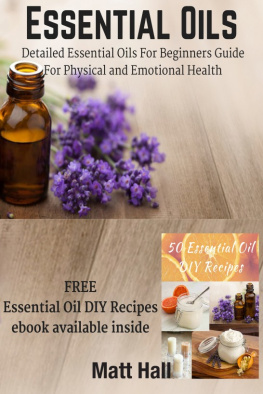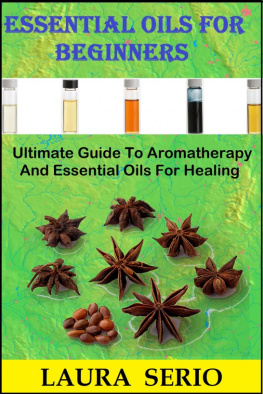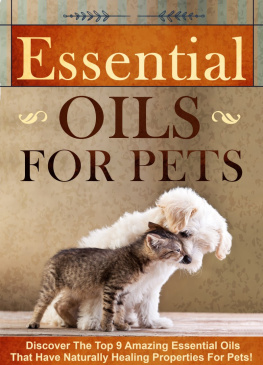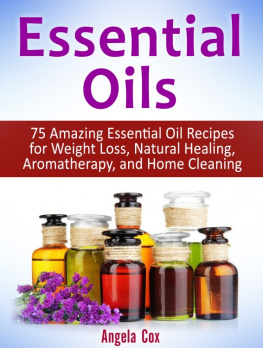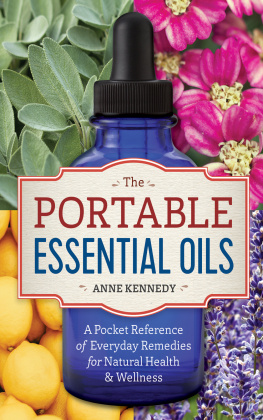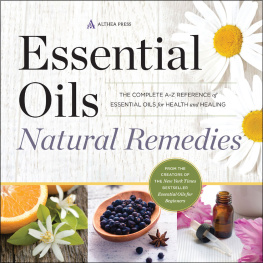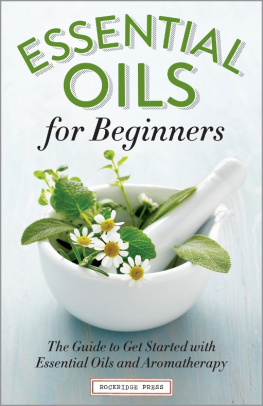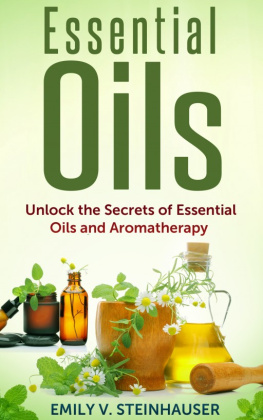Essential Oils
Detailed Essential Oils For Beginners Guide ForPhysical and Emotional Health
Matt Hall
~~~
Smashwords Edition
Copyright 2015 by Higher Living LLC - Allrights reserved.
This document is geared towards providingexact and reliable information in regards to the topic and issuecovered. The publication is sold with the idea that the publisheris not required to render accounting, officially permitted, orotherwise, qualified services. If advice is necessary, legal orprofessional, a practiced individual in the profession should beordered.
- From a Declaration of Principles which wasaccepted and approved equally by a Committee of the American BarAssociation and a Committee of Publishers and Associations.
In no way is it legal to reproduce,duplicate, or transmit any part of this document in eitherelectronic means or in printed format. Recording of thispublication is strictly prohibited and any storage of this documentis not allowed unless with written permission from the publisher.All rights reserved.
The information provided herein is stated tobe truthful and consistent, in that any liability, in terms ofinattention or otherwise, by any usage or abuse of any policies,processes, or directions contained within is the solitary and utterresponsibility of the recipient reader. Under no circumstances willany legal responsibility or blame be held against the publisher forany reparation, damages, or monetary loss due to the informationherein, either directly or indirectly.
Respective authors own all copyrights notheld by the publisher.
The information herein is offered forinformational purposes solely, and is universal as so. Thepresentation of the information is without contract or any type ofguarantee assurance.
The trademarks that are used are without anyconsent, and the publication of the trademark is without permissionor backing by the trademark owner. All trademarks and brands withinthis book are for clarifying purposes only and are the owned by theowners themselves, not affiliated with this document.
Smashwords Edition, License Notes
This ebook is licensed for your personalenjoyment only. This ebook may not be re-sold or given away toother people. If you would like to share this book with anotherperson, please purchase an additional copy for each recipient. Ifyoure reading this book and did not purchase it, or it was notpurchased for your use only, then please return to your favoriteebook retailer and purchase your own copy. Thank you for respectingthe hard work of this author.
Introduction
SPECIAL BONUS: we have a free course that weteach about the essential oils and how to start using them. Ahighlight of this course is a very detailed module on the scienceand chemistry of essential oils.
FREE 7 Day E-Course and
FREE 50 Essential Oil DIY RecipesEbook.
Along with this course we also would like togift you with our free 50 Essential Oil DIY Recipes ebook.This book will teach you how to make some awesome do it yourselfrecipes. Some of the recipes included are:
- Natural deodorant
- Ginger lime sugar scrub
- Essential healing salve
- Natural herbal hairspray
- Yoga mat spray
- And 45 other awesome recipes youll love.
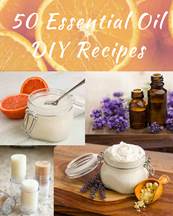
You can access this free course and ebook byclicking the image above or you can just CLICKHERE .
Table of Contents
Chapter 1: What Are Essential Oils?
Essential oils are natural aromatic compoundsextracted from plants. The oils are referred to as essentialbecause they contain the essence of the plant from which they wereextracted. Actually, the term essential oil is short for theoriginal term quintessential oil. This is based on theAristotelian idea that all matter is made up of four main elements(water, earth, air, and fire). Additionally, there was the fifthelement, the quintessence, which was considered to be in spiritform or rather life force. Evaporation and distillation were viewedas ways of extracting the spirit from the plant. This has beenreflected to even todays world where we can see the word spiritsbeing used to describe distilled alcoholic drinks such as eau devie, whiskey and brandy. In the current days, the idea has been letgo of since we know that essential oils are actually physical innature and are composed of various mixtures of complexchemistry.
Generally, essential oils are extracted fromthe source plant through distillation, normally using steam. Thereare however other processes through which essential oils can beextracted including solvent extraction and expression.
Essential oils are highly potent; if animpure oils are applied undiluted they may have adverse effects ifused. Therefore, you must follow certain safety precautions whenhandling essential oils. The safety precautions will be outlinedlater in the book. You also must be extremely confident in purityof the brand you use (to get a lot more info and our recommendationfor brands click here we are not allowed to talk about specificbrands in this book so youll want to connect with us in other waysto get that crucial info ;) ).
The potency of a specific essential oildepends on the compounds present in the oil, frequency of use,dosage and the method used to apply it. The quality of the oil (howpure the oil is, integrity and grade) can also affect potency ofthe essential oil.
In the recent decades, interest in the use ofessential oils has been seen to grow after the discovery of theirmultiple uses.
What role do the essential oils play inplants?
You might be wondering what the purpose ofthe essential oils is in the plants. Let me explain to you whyessential oils are important.
When the essential oils are in the plant,they change their chemical composition constantly. This helps theplant to be able to adapt to any external or internal environmentchanges easily. Additionally, research done has shown that theplants produce essential oils for a number of reasons,including:
To attract agents of pollination anddispersal: insects are the main agents of pollination. Justlike humans, they are attracted to specific plants because of theirscent, structure, or color. The scent of the flower is the mainattraction for insects. The essential oil present in the plant isresponsible for the different scents in different plants.
Allelopathy: this is when plantscompete for dominance in an area/zone. Some plants releasechemicals into the air that prevents other plants or vegetationfrom growing there. The sage bush is a good example of such plants.It releases chemicals such as camphor and eucalyptol to effectivelydeal with other plant species growing in the area.
To defend themselves against animals andother insects: some plants make use of terpenoid compoundspresent in their essential oil composition to deter animals andinsects that may approach as a self defense mechanism.
To protect the plant from bacterial andfungal infections: most essential oils are antifungal andantibacterial in nature. This helps some plants like the evergreensto protect themselves from certain organisms that might pose athreat to their survival.
Now that we know how important essential oilsare to plants, where are the essential oils stored in the plant?The essential oils can either be stored in the external or internalsecretory structures of a plant. The external ones are found on thesurface of the plant where you just have to touch the plant lightlyand the aroma will be on your skin. On the other hand, the internalones are found inside the plant material where you will have tobreak a part of the plant such as the leaf to smell the aroma ofthe essential oil.

